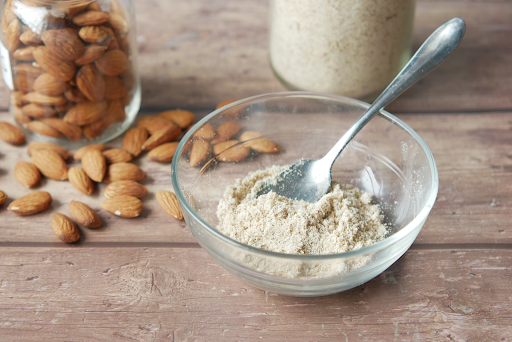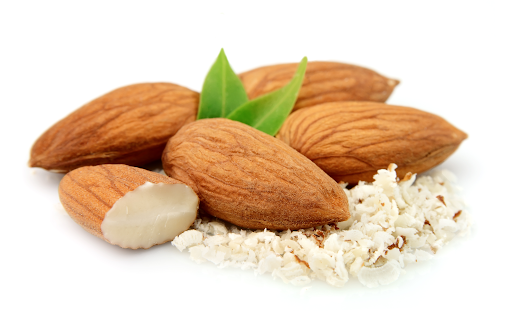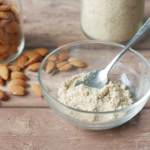How to Grind Almonds: A Step-by-Step Guide
Almond powder, almond flour, and almond meal might sound like different products, but they all come from the same source: almonds. The only difference lies in their texture and how they’re processed. For instance, almond powder is the finest option and works well for delicate treats like macaroons. Almond flour, as the name suggests, is more like traditional flour and has become a gluten-free substitute for wheat flour. Last but not least, we have almond meal, which is the coarsest option and is used as a crunchy topping for your favorite dishes. Now, the big question: how do you turn almonds into these different textures? Keep reading to find out.
How to Blanch Almonds

Before we dive into how to grind almonds, it’s important to know how to blanch them. This is an important step that will be mentioned a lot below. Here’s how to do it:
- Start by bringing a pot of water to a boil. Once it starts boiling, add your almonds. Let them boil for just a minute; any longer, and they might become too soft.
- After a minute, drain the almonds and rinse them with cold water.
- Next, gently slip the skins off the almonds by squeezing each one between your fingers. The skins should come off quite easily, revealing the smooth, white almond inside.
- Once you’ve removed all the skins, pat the almonds dry with a paper towel. Do not grind almonds when damp or wet. This could result in almond butter.
How to Make Almond Powder
Ready to make your own almond powder? Here’s a step-by-step guide to help you create this versatile ingredient right in your kitchen:
Step 1: Choose Your Almonds
Start with some high-quality raw almonds. You can use either chopped almonds or whole ones. If you want the finest powder, go for blanched almonds without the skin.
Step 2: Start Grinding
Pop your almonds into a food processor or a high-speed blender. Pulse the almonds until they reach a fine, powder-like consistency.
Step 3: Sieve for a Smooth Texture
To make the texture even finer, pass the ground almonds through a sieve. This step is great for catching any larger bits that might have escaped the blades.
Step 4: Store it
Transfer your freshly made almond powder to an airtight container. Keep it in a cool, dry place or in the fridge if you’re not planning to use it right away. You can use it in macaroons, delicate pastries, or as a gluten-free flour substitute.
How to Make Almond Flour
Now, let’s explore how to make blanched almond flour, a staple for gluten-free and health-conscious bakers everywhere:
Step 1: Select Your Almonds
For almond flour, you can choose either whole or blanched almonds. Blanched almonds usually give a smoother flour, but whole almonds work great too for a more natural, rustic feel.
Step 2: Begin Grinding
Add your almonds to a food processor and start grinding. Your goal is to achieve a consistency that’s more like flour than powder. A few pulses in the processor should do the trick.
Step 3: Sieve and Repeat
Just as with almond powder, pass your ground almond pulp through a sieve. This will separate the finer flour from the slightly larger bits. You can re-grind the larger bits or save them for another use.
Step 4: Store Your Flour
Similar to almond powder, transfer your homemade almond flour into an airtight container to keep moisture at bay. This ingredient is great for everything from cakes to cookies and pancakes.
How to Make Almond Meal

With its coarser texture and nutty flavor, almond meal is a fantastic addition to various almond meal recipes. Here’s how to make it in a few easy steps:
Step 1: Pick Your Almonds
Unlike almond flour, for almond meal, you’ll want to use whole-slivered almonds with their skins on.
Step 2: Time to Grind
Place your almonds into a food processor. Pulse them until they reach a coarse, sandy texture. Remember, we’re not looking for a fine powder here, but a grittier feel.
Step 3: Start Using Them
Homemade almond meal is super versatile. You can use it in bread, as a breading for meats, or even sprinkle it on yogurt, almond milk, and salads for a crunchy addition.
Top Tips for Grinding Almonds
Grinding almonds at home can be fun, especially when you know a few tricks of the trade. Here are some top tips to help you get the best results and enjoy the process:
- Grinding generates heat, which can release oils from the almonds and lead to clumping. If you notice this happening, take a break and let them cool down before continuing.
- If you’ve blanched your almonds or if they’re a bit moist, make sure to dry them thoroughly before grinding. Moisture can lead to clumpy almond flour or meal.
- It’s a good idea to grind almonds that are at room temperature. Cold almonds straight from the fridge might not grind as finely.
- Keep in mind that almonds will shrink in volume when ground. One cup of whole almonds will yield slightly less than one cup of ground almonds.
- If you’re making just almond flour, consider adding a little bit of cornstarch (about 1 teaspoon per cup of almonds). This can help prevent clumping.
Why Grind Almonds at Home?
When you grind almonds at home, you’re guaranteed the freshest result. Store-bought almond flour or meal can sit on shelves for months, losing flavor over time. Secondly, it’s cost-effective. Buying whole almonds in bulk is often cheaper than purchasing pre-ground products.
Third, there’s the aspect of control. When you grind almonds at home, you control the texture. Plus, you know exactly what’s going into your food – no added preservatives or fillers, just pure, unadulterated almonds.
And lastly, it’s just plain satisfying. There’s something special about taking a whole ingredient and transforming it into something new with your own hands.
How Long Do Ground Almonds Last?
The shelf life of ground almonds depends on how you store them. If kept in an airtight container in a cool, dry place (like your pantry), they can last for about a month. But if you want to extend their life even further, consider storing them in the refrigerator or freezer. In the fridge, they can stay good for up to 3 months, and in the freezer, they can last up to 6 months. Just remember to seal them well to keep out moisture and other food odors.
It’s also a good idea to give them a quick sniff before using them. If they smell rancid or stale, it’s best to toss them out. Fresh ground almonds should have a sweet, nutty aroma.
Summary
Knowing how to grind almonds is a must-have skill if you love baking or cooking with these versatile nuts. With the right equipment and simple steps, you can effortlessly create almond flour, almond meal, or almond powder for different recipes.
And, to make your almond grinding experience even more efficient, consider the MisterChef Food Processor. With its powerful performance and precision, the MisterChef food processor ensures you achieve the perfect consistency every time. Shop with us today.






